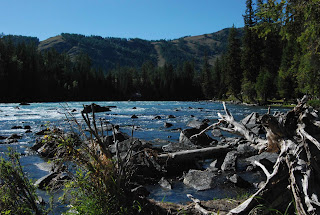Today is critical as we want to see the "Valley of One Thousand Buddhas" the "Magoa Caves" and travel 450 km to the start of the Silk Road at Jiayuguan Fort the end of the great Wall of China.
Time is running out for us as we only have two days left and we want to visit the city Zhangye where Marco Polo spent a year waiting for permission to enter the court of Ghengis Khan. And we gotta book a flight out of Lanzhou which is another 12 hours bus ride from Zhangye.
 |
| The Magoa Caves, Dunhuang, Dansu Province, China |
The day dawned bright and not too hot as we are in the desert oasis on the edge of the Tuklakaman Desert. It is really !!xx that the Chinese do not stir early. We try to leave early and the first buses and shops do not open till 9 or 10 It is virtually impossible to get going early.
Now last night we had a travel agent knock on our door and demand we go on her bus to the caves. The deal was a tour of the caves and a bus ride there and back. We were not amused. She was very aggressive. More on that in a moment.
For now we focus on brekkie and flight tickets out of Lanzhou to Beijing for 2 days time. We find a cafe that serves an egg brekkie (not noodles) and some sort of black stuff called coffee. (Citt is tonguing for a cappuccino). More importantly in the corner of the cafe is a computer that works. So we book on line a flight ticket Lanzhou - Beijing for late on the 12th. Dunno how we will get there.
(yeah I know wing it).
 |
| The 35 meter high Buddha carved from the cliff |
The bus for Jiayuaguan leaves on the hour every hour so we allow 4 hours for the Cave Tour.
We are not happy as we have realised that this is one of the wonders of the ancient world and we only allow 2 hours to see it but in hindsight there are 240 caves and they only allow visitors into 10 and the tour takes 1.5 hours and no photos or free walking. So there is no reason to stay longer. The monks caves are a long walk and we are not real interested in them but you may be if you go.
 |
| Gate to Dunhuang |
 |
| Highway signs |
We caught our bus for Jiayuguan and we found out it is a 5 hour ride so we are going to be short of time to photograph the fort which is a disappointment to us.
 |
| East gate keepers office to fort |
 |
| East gate to fort |
We are in a huge industrial city with lots of traffic and stuff. Luck has it our taxi is aware of our destination and we make it with time to spare.
This marks the outer boundary of the Han Empire 12th century and the end of the great wall. From here anyone who passed through the gates heading west were either expelled from the Empire travellers or merchants. From here on to the West it was uncharted territory controlled by warlords and heathens uncharted territory deserts mountain passes bandits and thieves.
 |
| West gate entering the Empire traveling East. |
We stood very very still dreaming listening to the sound of exhausted camels & donkeys There was beautiful string music coming from the camp fires. Soft sounds of languages long gone, relating tales of mystical mountains, cities over the desert. Kashgar, Bukara, Kiev, Smyrna, Damascus, Liban, Cairo, Bactria, Kabul, Peshawar, Lahore, Delhi, Somakand, Penjikent and Konstantinople. Stories of heroics, travelers tales, great feats.
The soft unmistakable smell of pot and hash on the wind mixed with the smell of the cooking pots of curry, garlic, five spice and exotic spices from Thailand Persia and Turkey.
 |
| The West gate. The last gate to the known world. Jiagugan Fort the start of a traders journey through uncontrolled lands. |
 |
| Sunset on the West Gate Jiayugauan fort. Photo: Citt Williams |
Citt and I had travelled so far on the Silk Road. It is a long exciting journey from the Mediterranean to Jiayuguan in China. Covering high mountain plateaus deserts and ancient cities en route.
The light is gone and it is time to depart this time forgotten fort trading post
We hear the sounds of the Motor-way it is 4 lanes heading West.
It is not how you start but how you finish. A long journey is many steps
They say the Fort was so well engineered that only one brick was over ordered and that brick sits above the West gate.
Tomorrow the last days 48 hours travel.






















